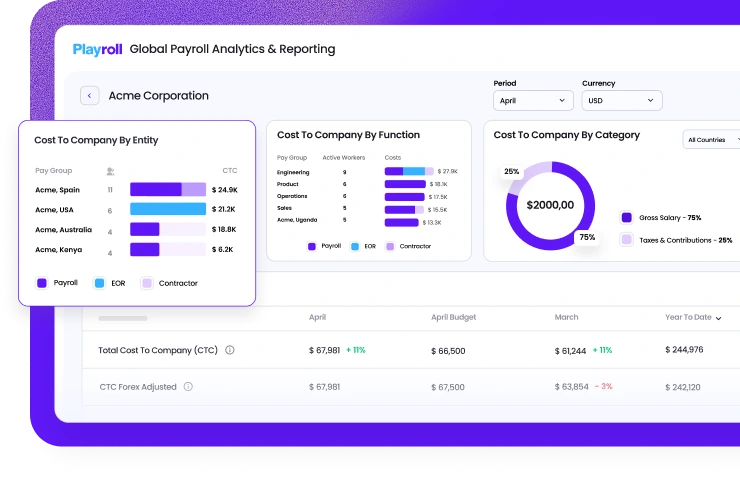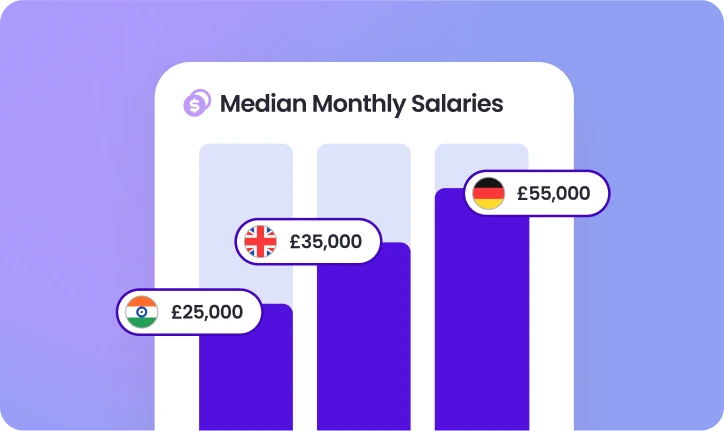
Minimum Wage: The statutory minimum wage in Peru is 1,130 PEN per month for a typical 48 hour work week.

Working Hours: In Peru, the standard work week is capped at 48 hours, typically distributed across 6 days with 8-hour daily limits.


Payroll Taxes: In Peru, employers contribute about 9% in payroll taxes, which typically cover social security, health care, and other statutory benefits.

Average Salary: The average salary in Peru is approximately $450 USD (around 2,134 PEN).
Hiring independent contractors has boomed in popularity because of the cost savings and flexibility they offer. It can be a great option if you require niche skills or short-term project support. Contractors allow businesses to access specialized skills quickly, without the time and cost of setting up a local entity.
However, it’s important to know the limits of this model: contractors are not a substitute for full-time employees. Relying on them for ongoing, long-term roles can create serious compliance risks, including employee misclassification, which can lead to fines, back taxes, and reputational damage.
Playroll’s contractor management solutions make it simple to compliantly engage, onboard, and pay contractors around the world. We provide clear visibility into agreements, streamline payments, and reduce compliance risks – so you can focus on getting the work done. And when you’re ready to take the next step, we can help seamlessly convert contractors into full-time employees through our global Employer of Record service.
From compliant contracts to competitive benefits, Playroll’s EOR services keep you aligned with local labor laws and regulations, safeguarding your business, so you can focus on growth.
Book a Demo
Businesses can only operate smoothly in Peru if they comply with local labor laws including drafting compliant employment contract agreements and meeting taxation and payroll obligations. Learn more about the employment laws and regulations in Peru below, to avoid any compliance issues.
Employment Contract Requirements
When hiring employeesin Peru, businesses must provide a written employment contract in both the local language and English. There are two types of contracts: fixed-term and indefinite-term. Most employers in Peru prefer indefinite-term contracts. The contract should include details like:
- Employer and employee details
- Compensation and payroll cycle
- Job responsibilities
- Termination clauses and notice periods
Onboarding Process
We can help you get a new employee started in Peru quickly, with a minimum onboarding time of just 1-2 working days. The timeline starts once the employee submits all required information onto the Playroll platform and completes any necessary local authority registrations.
For non-nationals, the Right to Work assessment (if applicable) may add up to three extra days. Additional time may be needed for follow-ups on this assessment. Please note, payroll cut-off dates can impact the actual start date. Playroll's payroll cut-off date is the 10th of each month unless otherwise specified.
Probation Period in Peru
The probationary period in Peru is three months. It can be extended to six months for managerial or specialized skill positions or even a year in exceptional cases.
The average monthly salary in Peru in 2025 is approximately $450 USD (around 2,134 PEN). Salaries vary based on experience, industry, and location - senior professionals and those in high-demand sectors like IT can earn significantly more, while entry-level or service-sector roles typically earn less. Wages are generally higher in Lima and major urban areas compared to rural regions. Peru's current economic landscape includes moderate GDP growth (around 2.8%–3.1%), relatively low inflation (~2%), and an unemployment rate hovering near 6%–7%, all of which influence wage levels and trends.
In Peru, the standard workweek is capped at 48 hours, typically distributed across 6 days with 8-hour daily limits. Employers must provide minimum rest periods, including a 45-minute daily break and 24 consecutive hours of weekly rest.
Overtime must be voluntary and compensated at premium rates: 25% extra for the first two hours, 35% for subsequent hours, and 100% (double pay) for work on rest days or holidays.
Special provisions exist for night shift workers (10 PM - 6 AM), who receive a 35% premium, and for managerial staff, who are exempt from standard hour limitations. Employers must maintain accurate time records and ensure compliance to avoid significant penalties, legal disputes, and reputational damage.
Growing your team in Peru is exciting, but it’s not without challenges. Local labor laws are often nuanced, and hiring without the right legal structure or processes can lead to misclassification, non-compliance penalties, or disputes. An Employer of Record removes that risk by acting as the legal employer on your behalf, taking full responsibility for compliance, contracts, payroll, and employee benefits.
This gives you the freedom to scale at your own pace, whether you're adding one employee or building out an entire function, without the burden of setting up and managing a local entity. You remain in control of day-to-day responsibilities and performance, while the EOR ensures every hire is legally protected and properly supported. It's a strategic way to expand globally without spreading your internal team too thin or exposing your business to legal liabilities in unfamiliar markets.
Fiscal Year in Peru
1 January- 31 December is the 12-month accounting period that businesses in Peru use for financial and tax reporting purposes.
Payroll Cycle in Peru
The payroll cycle in Peru is usually monthly, with employees being paid by the last working day of the month.
Minimum Wage in Peru
As of 1 January 2025, Peru's minimum wage rates has increased to 7.06 PEN per hour, amounting to 1,130 PEN per month for a typical 48 hour work week.
The minimum wage is reviewed periodically, typically annually, by the National Council of Labor and Employment (CNTPE). It is based on economic indicators and factors like inflation, cost of living, and economic growth.
Bonus Payments in Peru
It is mandatory for employers to provide 13th-month and 14th-month payments. Employees receive an additional month's salary twice a year. The first payment occurs in July (payable by 15 July), around Peru's Independence Day, and the second payment is made at the end of the year (payable by 15 December), around Christmas.
Employer Tax Contributions
Employer payroll contributions are generally estimated at an additional 9% on top of the employee salary in Peru.
Employee Payroll Tax Contributions
In Peru , the typical estimation for employee payroll contributions cost is around 12.50% to 13.00%.
Individual Income Tax Contributions
The income tax rates are applied on a progressive scale expressed in UITs (Tax Units). The value of one UIT is set by the government at the beginning of each year. The current value of 1 tax unit is 5,150 PEN.
Pension in Peru
The national pension system is funded through mandatory employee contributions. Employers are required to make monthly withholdings for pension fund contributions, which are equal to 13% of the compensation received by the employee for the National Pension System or approximately 12.5% for the Private Pension System (with 10% going to the personal pension account and almost 2.5% to insurance and commissions)

In Peru, employers are responsible for withholding various mandatory contributions from employees, including income tax, pension system contributions (either the National Pension System or the Private Pension System), and health insurance through EsSalud, which is set at 9% of an employee's monthly salary. Additionally, employers must provide a 13th and 14th-month salary payment, as well as other benefits such as family allowances and service time compensation.
The payroll cycle typically runs monthly, and employers must file monthly reports with the tax authorities, including income tax withholdings and pension contributions. Failure to comply with these obligations can lead to penalties, making accurate payroll processing essential for businesses in Peru.
Using payroll management software can help employers consolidate payroll data, automate calculations, ensure accurate withholding, and stay compliant with Peru's tax regulations and contribution rates.
Minimum Wage in Peru
As of 1 January 2025, Peru's minimum wage rates has increased to 7.06 PEN per hour, amounting to 1,130 PEN per month for a typical 48 hour work week.
Employees expect to be paid accurately, on time, and in full compliance with local standards. When you're hiring in Peru, providing a smooth payroll experience is critical to retention and trust. An Employer of Record ensures that employees receive what they’re owed, without errors, delays, or confusion about taxes or benefits.
Key Ways an EOR Supports Payroll in Peru:
- Reliable Salary Payments: Ensures employees are paid promptly in local currency.
- Clear Payslips & Documentation: Provides employees with compliant, understandable records.
- Correct Benefits & Contributions: Delivers legally mandated contributions and any changes in compensation, like bonuses.
- Payroll Setup & Processing: Handles salary calculations, tax withholdings, and local reporting obligations.
- Boosts Employee Confidence: Builds trust with compliant, consistent payroll operations.
Make better business decisions by consolidating global payroll data, while seamlessly syncing your existing payroll operations.
Book a Demo
In Peru, work permits and visas are essential for employers hiring foreign workers. The process involves submitting applications, paying fees, and meeting eligibility criteria. Key visa types include the Temporary Work Visa, Resident Work Visa, and Digital Nomad Visa. Employers must ensure compliance with local labor regulations when sponsoring foreign employees.
Mandatory Leave Entitlement in Peru
The annual leave entitlement in Peru is 30 days for a full time worker. These can include public holidays on top of that or within those days, which would otherwise be unpaid. The 30 calendar days can be taken consecutively or split into 15 consecutive days that can be split further into minimum 7 or 8 days and the remaining 15 days split between minimum 1- 7 days.
Public Holidays In Peru
Peru observes a total of 10 national holidays, along with additional regional holidays that vary based on the employee's location.
Paid Time Off in Peru
Employees in Peru are entitled to 30 days of paid annual leave. Employees are eligible for annual leave after 12 months of work. Part-time employees, on the other hand, are entitled to six calendar days of paid leave per year. According to Peruvian law, 15 days of annual leave per year is compulsory, but the remaining 15 days may be exchanged for cash.
Maternity Leave In Peru
Female employees are entitled to 98 days of fully paid maternity leave, with the period split into 49 days before and 49 days after delivery. This can be extended by an additional 30 days in the cases of multiple births. Maternity benefits, equivalent to the mother's full wages, are provided by the social security agency (employer continues to pay the salary but is then reimbursed by Social Security).
Paternity Leave In Peru
Employees are entitled to a paid paternity leave of 10 consecutive calendar days in the case of natural or cesarean birth. If the birth is premature or involves multiple births, the entitlement increases to 20 days of leave.
Sick Leave In Peru
Employees are entitled to 365 days of paid sick leave per year. The employer covers the compensation for the initial 20 days of sickness, while the remaining 245 days are covered by social security. Sick leave requires the submission of a medical certificate.
Parental Leave In Peru
Peru does not have a separate shared parental leave policy.
Adoption Leave
Adoptive parents are eligible for 30 days of paid leave for each child adopted below the age of 12.
Civil Duty Leave
Firefighters and military personnel are entitled to paid leave if they are called up for service.
In Peru, failing to provide the correct employee benefits can have serious consequences. Mistakes in benefits administration may result in fines and harm your reputation as an employer. An Employer of Record ensures statutory benefits and leave are handled correctly, every time, and provides comprehensive options for extra perks to reward your team.
Beyond just avoiding legal issues, a well-managed benefits program builds trust with your employees. An EOR ensures benefits are set up quickly during onboarding, updated when employee status changes, and fully compliant with national regulations. They also manage communication with employees, so there’s no confusion around what’s offered and how to access it. This combination of legal compliance and positive employee experience is hard to replicate without local infrastructure. With an EOR, you can offer peace of mind to your team (and to yourself) knowing that your benefits program in Peru is running as it should.
Termination Process in Peru
The termination of employment varies depending on the terms outlined in the employment agreement and collective agreement. It is influenced by the type of contract and the reason for termination. Compliant terminations may occur through:
- Mutual Agreement
- Expiration of the Contract
- Objective Grounds
- Disciplinary Dismissal
Notice Period in Peru
Employers are required to provide a notice period of 6 to 30 days, depending on the reason for dismissal.
Severance in Peru
There is no statutory severance entitlement but an indemnity is payable in the event of an unfair dismissal (where company does not have described legal grounds to dismiss employee). In the event of unfair dismissal, employees are entitled to receive a legal indemnity of (total may not exceed in both cases, 12 months salaries):
- 1.5 times their monthly remuneration for each year of service, if the employee is on an indefinite employment contract. Periods of time less than 1 year must be paid proportionally.
- 1.5 times their monthly remuneration for each month remaining until the end of the fixed-term contract, if applicable.
Disclaimer
THIS CONTENT IS FOR INFORMATIONAL PURPOSES ONLY AND DOES NOT CONSTITUTE LEGAL OR TAX ADVICE. You should always consult with and rely on your own legal and/or tax advisor(s). Playroll does not provide legal or tax advice. The information is general and not tailored to a specific company or workforce and does not reflect Playroll’s product delivery in any given jurisdiction. Playroll makes no representations or warranties concerning the accuracy, completeness, or timeliness of this information and shall have no liability arising out of or in connection with it, including any loss caused by use of, or reliance on, the information.
.svg)
.svg)
.svg)

.svg)








.svg)



.png)









.webp)









.svg)